m (→References: Adjusting categories (AWB)) Tag: apiedit |
m (Changing Wikispecies links (using WspConvert.cs with AWB)) |
||
| Line 33: | Line 33: | ||
|reverse= *{{wp|en|Shield}}, {{wp|en|spear}}s, and {{wp|en|staff}}; value; year (1968) |
|reverse= *{{wp|en|Shield}}, {{wp|en|spear}}s, and {{wp|en|staff}}; value; year (1968) |
||
*Sprays, value, year (1981) |
*Sprays, value, year (1981) |
||
| − | *{{wp|en|African bush elephant|African elephant}} ('' |
+ | *{{wp|en|African bush elephant|African elephant}} (''{{wsp|Loxodonta africana}}''), value, year (1974-present) |
}} |
}} |
||
The '''20 [[cent]] [[coin]]''' is a current [[circulation]] and former [[commemorative coin|commemorative]] piece of the [[Swaziland|Kingdom of Swaziland]]. It has been issued in eight types since [[1968]], three under {{wp|en|King of Swaziland|King}} {{wp|en|Sobhuza II}} (1899–1982; <abbr title="Reigned">r.</abbr> 1921–1982) and five under {{wp|en|Mswati III}} (1968–; <abbr title="Reigning">r.</abbr> 1986–). The first type was distributed by the {{wp|en|Politics of Swaziland|Swazi government}}, while the other seven were issued by the [[Central Bank of Swaziland]] and its precursor, the Monetary Authority of Swaziland. All of the pieces were struck under commission at foreign mints, the first, sixth, seventh, and eighth at the [[South African Mint]] in {{wp|en|Pretoria}}, [[South Africa]], and the rest at the [[Royal Mint]] in {{wp|en|Llantrisant}}, [[Wales]], [[United Kingdom]]. |
The '''20 [[cent]] [[coin]]''' is a current [[circulation]] and former [[commemorative coin|commemorative]] piece of the [[Swaziland|Kingdom of Swaziland]]. It has been issued in eight types since [[1968]], three under {{wp|en|King of Swaziland|King}} {{wp|en|Sobhuza II}} (1899–1982; <abbr title="Reigned">r.</abbr> 1921–1982) and five under {{wp|en|Mswati III}} (1968–; <abbr title="Reigning">r.</abbr> 1986–). The first type was distributed by the {{wp|en|Politics of Swaziland|Swazi government}}, while the other seven were issued by the [[Central Bank of Swaziland]] and its precursor, the Monetary Authority of Swaziland. All of the pieces were struck under commission at foreign mints, the first, sixth, seventh, and eighth at the [[South African Mint]] in {{wp|en|Pretoria}}, [[South Africa]], and the rest at the [[Royal Mint]] in {{wp|en|Llantrisant}}, [[Wales]], [[United Kingdom]]. |
||
| Line 64: | Line 64: | ||
A bust of Sobhuza II is illustrated in the center of the obverse. The Swazi monarch is shown facing ¼ right, sporting his signature goatee, and wearing an ''inyoni'', a ceremonial {{wp|en|headdress}} worn by the King of Swaziland; a ''ligcebesha'', a type of traditional beaded necklace; and an ''umhelwane''. Inscribed in a counterclockwise direction along the rim below is the state title "SWAZILAND". |
A bust of Sobhuza II is illustrated in the center of the obverse. The Swazi monarch is shown facing ¼ right, sporting his signature goatee, and wearing an ''inyoni'', a ceremonial {{wp|en|headdress}} worn by the King of Swaziland; a ''ligcebesha'', a type of traditional beaded necklace; and an ''umhelwane''. Inscribed in a counterclockwise direction along the rim below is the state title "SWAZILAND". |
||
| − | The reverse features in its center a depiction of an {{wp|en|African bush elephant|African elephant}} ('' |
+ | The reverse features in its center a depiction of an {{wp|en|African bush elephant|African elephant}} (''{{wsp|Loxodonta africana}}''), a species of large {{wp|en|mammal}} native to parts of {{wp|en|Sub-Saharan Africa}}, including Swaziland. Such an animal serves a {{wp|en|national symbol}} of the African country, representing the ''{{wp|en|Ndlovukati}}'', whose role is similar to that of a {{wp|en|queen mother}} in other monarchies. The coin's rendition of the elephant solely shows the head of the animal facing right, with its two long {{wp|en|elephant tusk|tusks}} protruding outward and its trunk raised. The face value "20 CENTS" is printed next to the elephant, the numeral inscribed above in a large outlined font and the word "CENTS" engraved in a counterclockwise direction along the rim below. The Gregorian date of minting is written counterclockwise in {{wp|en|Western Arabic numerals}} along the coin's right periphery, separated from the word "CENTS" by the elephant's tusks. |
Over three years of production, more than 1,525,000 examples were produced, including over 1,502,000 pieces with a normal finish and 23,000 [[proof coin|proofs]]. An [[Swazi mint sets|unknown number]] of uncirculated normal pieces of 1974; all 13,000 of the 1974 proofs; and 3,231 of the 1979 proofs were sold to collectors in sets by the Central Bank of Swaziland. [[Mintage]] figures for the 1979 standard pieces are currently unavailable. |
Over three years of production, more than 1,525,000 examples were produced, including over 1,502,000 pieces with a normal finish and 23,000 [[proof coin|proofs]]. An [[Swazi mint sets|unknown number]] of uncirculated normal pieces of 1974; all 13,000 of the 1974 proofs; and 3,231 of the 1979 proofs were sold to collectors in sets by the Central Bank of Swaziland. [[Mintage]] figures for the 1979 standard pieces are currently unavailable. |
||
| Line 92: | Line 92: | ||
The obverse bears the same design as that of Swaziland's first circulating 20 cent piece, featuring in its center a bust of Sobhuza II facing ¼ right and wearing a goatee, ''inyoni'', ''ligcebesha'', and ''umhelwane''. Printed in a counterclockwise direction along the rim below is the state title "SWAZILAND". |
The obverse bears the same design as that of Swaziland's first circulating 20 cent piece, featuring in its center a bust of Sobhuza II facing ¼ right and wearing a goatee, ''inyoni'', ''ligcebesha'', and ''umhelwane''. Printed in a counterclockwise direction along the rim below is the state title "SWAZILAND". |
||
| − | An {{wp|en|amaranth}} ('' |
+ | An {{wp|en|amaranth}} (''{{wsp|Amaranthus}}''), a type of plant harvested for food in parts of Africa, is displayed in the middle of the reverse. Engraved to the upper left is the logo of World Food Day 1981 – which consists of an {{wp|en|Ear (botany)|ear}} of {{wp|en|wheat}} inside a circular border, its {{wp|en|Awn (botany)|awns}} dividing the letters "FAO". Also on the logo, the date "16 OCT", abbreviated for "16 October", is curved along the inside of the lower boundary, and the text "WORLD FOOD DAY" is arched in the same direction along the outside of the circle. Appearing next to the amaranth and logo is the face value "20 CENTS", the numeral "20" written horizontally above in a large outlined font and the word "CENTS" engraved counterclockwise in small print along the rim below. The inscriptions "FOOD FIRST" and "LIJAHA SISU", {{wp|en|Swazi language|Swazi}} for "food for all", are respectively engraved at the coin's upper left and right peripheries, flanking the "20". Both texts, which represent the theme of World Food Day 1981, travel clockwise along the top of the reverse. Inscribed at the lower right rim is the Gregorian date of minting, "1981". |
A total of 150,000 examples of the coin were produced, all with a standard finish. An unknown number of pieces were sold in [[Food and Agriculture Organization coin sets|FAO coin sets]]. |
A total of 150,000 examples of the coin were produced, all with a standard finish. An unknown number of pieces were sold in [[Food and Agriculture Organization coin sets|FAO coin sets]]. |
||
Latest revision as of 19:11, 1 January 2018
| 20 cents | |
|---|---|
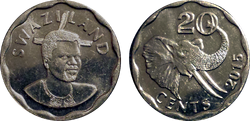
| |
| 2015 coin | |
| General information | |
| Country | |
| Value |
0.20 lilangeni |
| Years |
1968–present |
| Measurements and composition | |
| Mass |
|
| Diameter |
|
| Thickness |
|
| Composition |
|
| Appearance | |
| Shape |
|
| Alignment |
medallic |
| Edge |
|
| Obverse |
|
| Reverse |
|
| v · d · e | |
The 20 cent coin is a current circulation and former commemorative piece of the Kingdom of Swaziland. It has been issued in eight types since 1968, three under King Sobhuza II (1899–1982; r. 1921–1982) and five under Mswati III (1968–; r. 1986–). The first type was distributed by the Swazi government, while the other seven were issued by the Central Bank of Swaziland and its precursor, the Monetary Authority of Swaziland. All of the pieces were struck under commission at foreign mints, the first, sixth, seventh, and eighth at the South African Mint in Pretoria, South Africa, and the rest at the Royal Mint in Llantrisant, Wales, United Kingdom.
The first piece, a non-circulating commemorative, was issued in 1968 to celebrate Swaziland's independence from the United Kingdom that year. It was followed in 1974 by the first general circulation 20 cent piece of Sobhuza II, which continued to be struck until 1979. A circulating commemorative was then issued in 1981 in celebration of the that year's World Food Day. Four years after Sobhuza's death in 1982, Prince Makhosetive Dlamini succeeded his father as king, adopting the royal name Mswati III. A new circulating 20 cent piece bearing the new leader's likeness was then introduced shortly after his coronation in 1986. A fifth type bearing a modified likeness of Mswati was then struck from 1996 to 2005, followed by a sixth type in 2011, a seventh type (dated 2011) in 2013, and an eighth beginning in 2015.
All of the 20 cent coins currently hold legal tender status in their country of origin, each carrying a face value of 0.20 lilangeni, the equivalent of 0.20 South African rand. As a collectors' piece, the 1968 coin does not circulate frequently, if at all, despite its status as legal tender. The other types see frequent circulation.
On April 20, 2016, the Central Bank of Swaziland announced it had begun recalling all pre-2015 circulation coins, including all of the earlier 20 cent pieces. They are expected to be out of circulation by September 1.
Coins[]
Coins of Sobhuza II (1968–1981)[]
Independence coin (1968)[]
Swaziland became a protectorate of the South African Republic, a neighboring southern African Boer state, through a convention in 1894. This protectorate, however, was very short lived. With the conclusion of the Second Boer War (1899–1902), fought between the Boer states and the United Kingdom, Swaziland became a British protectorate in 1906. For nearly 60 years the territory remained under British control, but was finally granted its independence in 1968, during the later reign of King Sobhuza II. In celebration of Swaziland's independence, that year the Swazi government issued a series of commemorative coins in denominations of 5, 10, 20, and 50 cents, 1 luhlanga, and 1 lilangeni. All of the pieces were struck under contract at the South African Mint in Pretoria and designed by South African artist Thomas Sasseen.
The 20 cent coin is composed of .800 fine silver and measures 6.63 grams in mass and 24.1 millimeters in diameter. It has medallic alignment; raised, undecorated rims; and a reeded edge, and like most coins, is round in shape.
A bust of Sobhuza II appears in the center of the obverse. It shows the monarch facing ¾ left and wearing his signature goatee; a necklace; and an umhelwane, a traditional Swazi fabric covering the torso. Printed counterclockwise along the rim below is the caption "SOBHUZA II", and written in the opposite direction above, extending from the coin's left to right peripheries, is the legend "SWAZILAND INDEPENDENCE". The "T.S." initials of the designer are engraved in small print to the bottom right of Sobhuza's likeness.
An ox hide shield of the Emasotsha Regiment is presented vertically in the middle of the reverse, superimposing two assegais and a staff decorated with injobo tassels. Such a depiction also appears on the flag of Swaziland, but on the flag it is displayed horizontally instead of vertically. The face value "20c
–", abbreviated for "20 cents", is written to the lower left, angled toward the bottom of the piece. It is accompanied by the Gregorian date of minting, "1968", which is inscribed to the lower right of the reverse's central illustration, and is slanted to the upper right. Engraved in small print below the bottom left portion of the shield are the "T.S." initials of the artist.
Ten thousand examples of the 20 cent piece were struck, all with a proof finish. They were sold exclusively in sets with the other 1968 commemoratives, excluding the 1 lilangeni coin.
General circulation coin (1974–1979)[]
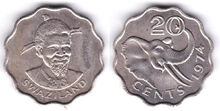
1974 coin
After becoming independent from the United Kingdom, Swaziland initially adopted the South African rand as its currency. However, unable to reach an agreement with South Africa on how to share seigniorage of the rand in Swaziland, the country adopted the lilangeni not long after in 1974. That year the newly founded Monetary Authority of Swaziland (now the Central Bank of Swaziland) commissioned the Royal Mint to strike the first series of Swazi circulation coins, which consisted of pieces in denominations of 1, 2, 5, 10, 20, and 50 cents, and 1 lilangeni. Michael Rizzello (1926–2004), a prominent Italian-born British sculptor, was contracted by the mint to design all seven coins.
The 20 cent piece, which was struck intermittently until 1979, is composed of a cupronickel alloy and measures 5.6 grams in mass, 25.2 millimeters in diameter, and 1.5 millimeters in thickness. It has medallic alignment; raised, undecorated rims; and a plain edge. The coin is scalloped in shape, having 12 notches. There is a depression in the scalloping at the top and bottom of both sides.
A bust of Sobhuza II is illustrated in the center of the obverse. The Swazi monarch is shown facing ¼ right, sporting his signature goatee, and wearing an inyoni, a ceremonial headdress worn by the King of Swaziland; a ligcebesha, a type of traditional beaded necklace; and an umhelwane. Inscribed in a counterclockwise direction along the rim below is the state title "SWAZILAND".
The reverse features in its center a depiction of an African elephant (Loxodonta africana), a species of large mammal native to parts of Sub-Saharan Africa, including Swaziland. Such an animal serves a national symbol of the African country, representing the Ndlovukati, whose role is similar to that of a queen mother in other monarchies. The coin's rendition of the elephant solely shows the head of the animal facing right, with its two long tusks protruding outward and its trunk raised. The face value "20 CENTS" is printed next to the elephant, the numeral inscribed above in a large outlined font and the word "CENTS" engraved in a counterclockwise direction along the rim below. The Gregorian date of minting is written counterclockwise in Western Arabic numerals along the coin's right periphery, separated from the word "CENTS" by the elephant's tusks.
Over three years of production, more than 1,525,000 examples were produced, including over 1,502,000 pieces with a normal finish and 23,000 proofs. An unknown number of uncirculated normal pieces of 1974; all 13,000 of the 1974 proofs; and 3,231 of the 1979 proofs were sold to collectors in sets by the Central Bank of Swaziland. Mintage figures for the 1979 standard pieces are currently unavailable.
| Mintages | |
|---|---|
| Year | Mintage |
| 1974 | 502,000 |
| 1974 Proof | 13,000 |
| 1975 | 1,000,000 |
| 1979 | Unknown |
| 1979 Proof | 10,000 |
World Food Day coin (1981)[]
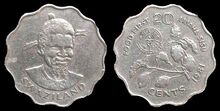
1981 World Food Day coin
In honor of the establishment of the Food and Agriculture Organization (FAO) on October 16, 1945, World Food Day has been celebrated on October 16 every year from 1979 to the present. Some of the objectives of the annual observance include raising awareness on hunger and poverty and encouraging more agricultural production. Since 1981 the FAO has selected annual themes to highlight specific areas and bring them to attention. Around 1981, in observance of World Food Day and its theme, "food comes first", the Central Bank of Swaziland contracted the Royal Mint to strike circulating commemoratives in denominations of 20 cents and 1 lilangeni. Both carry designs by Italian-British artist Michael Rizzello.
The 20 cent piece, like the general circulation coin of Sobhuza II, is composed of a cupronickel alloy and measures 5.6 grams in mass, 25.2 millimeters in diameter, and 1.5 millimeters in thickness. It has medallic alignment; raised, undecorated rims; and a plain edge, and is scalloped in shape. The coin has 12 rounded notches and a depression in the scalloping at the top and bottom of both sides.
The obverse bears the same design as that of Swaziland's first circulating 20 cent piece, featuring in its center a bust of Sobhuza II facing ¼ right and wearing a goatee, inyoni, ligcebesha, and umhelwane. Printed in a counterclockwise direction along the rim below is the state title "SWAZILAND".
An amaranth (Amaranthus), a type of plant harvested for food in parts of Africa, is displayed in the middle of the reverse. Engraved to the upper left is the logo of World Food Day 1981 – which consists of an ear of wheat inside a circular border, its awns dividing the letters "FAO". Also on the logo, the date "16 OCT", abbreviated for "16 October", is curved along the inside of the lower boundary, and the text "WORLD FOOD DAY" is arched in the same direction along the outside of the circle. Appearing next to the amaranth and logo is the face value "20 CENTS", the numeral "20" written horizontally above in a large outlined font and the word "CENTS" engraved counterclockwise in small print along the rim below. The inscriptions "FOOD FIRST" and "LIJAHA SISU", Swazi for "food for all", are respectively engraved at the coin's upper left and right peripheries, flanking the "20". Both texts, which represent the theme of World Food Day 1981, travel clockwise along the top of the reverse. Inscribed at the lower right rim is the Gregorian date of minting, "1981".
A total of 150,000 examples of the coin were produced, all with a standard finish. An unknown number of pieces were sold in FAO coin sets.
Coins of Mswati III (1986–present)[]
First portrait coin (1986)[]
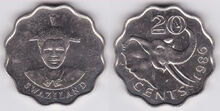
1986 coin
Before his death in 1982, Sobhuza appointed Prince Makhosetive Dlamini, one of his sons, to succeed him as King of Swaziland. However, being only 15 years old at the time of his father's death, Makhosetive was considered too young to ascend the throne, and Queen Dzeliwe (1927–2003), one of Sobhuza's wives, was selected to fulfill the monarchical duties as regent until Makhosetive came of age. After an internal dispute though, Queen Ntfombi (1950–), Makhosetive's mother, replaced Dzeliwe as regent in 1983. She held this position until 1986, when her son was crowned King of Swaziland and assumed the name Mswati III.
Excluding the 1 cent piece, which was minted into 1983, no Swazi circulation coins were produced during the regencies of Dzeliwe and Ntfombi. Shortly after Mswati III came to power in 1986, the next series of coins was introduced. With the exception of a 2 cent coin, the series consisted of the same denominations as the previous series: 1, 5, 10, 20, and 50 cents, and 1 lilangeni. The Central Bank of Swaziland commissioned the Royal Mint to strike all six coins, which are misattributed In the popular Standard Catalog of World Coins to Queen Dzeliwe.
The 10 cent coin of the series, minted only in 1986, is composed of a cupronickel alloy and measures 5.6 grams in mass, 25.2 millimeters in diameter, and 1.5 millimeters in thickness. It has medallic alignment; raised, undecorated rims; and a plain edge, and is scalloped in shape. The piece has 12 rounded notches and a depression in the scalloping at the top and bottom of both sides.
A facing bust of Mswati III wearing an inyoni and ligcebesha is illustrated in the center of the obverse. Printed in a counterclockwise direction along the rim below is the state title "SWAZILAND".
The reverse follows the design of the first general circulation 20 cent piece. The head of an elephant appears in the center, vertically dividing the face value "20 CENTS". Written counterclockwise along the coin's right boundary is the Gregorian date of minting, "1986".
Mintage figures for the 1986 coin are currently unavailable. Only business strikes and uncirculated pieces in mint sets are known to have been produced.
Second portrait coins (1996–present)[]
Scalloped coin (1996–2005)[]
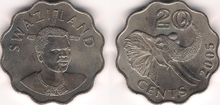
2005 coin
From 1995 to 1996, the Central Bank of Swaziland introduced a new series of coins in denominations of 1, 5, 10, 20, and 50 cents, and 1, 2, and 5 emalangeni. Like all previous series of Swazi circulating coins, all of the pieces were struck under commission at the Royal Mint in the United Kingdom.
The 20 cent piece of the series, which was struck almost annually from 1996 to 2005, is composed of cupronickel and measures 5.6 grams in mass, 25.2 millimeters in diameter, and 1.5 millimeters in thickness. It has medallic alignment; raised, undecorated rims; and a plain edge, and is scalloped in shape, having 12 rounded notches. On examples from 1998 and 2000, there is an elevation in the scalloping at the top and bottom of both sides; all other pieces have a depression at the same positions.
The obverse features an updated bust of Mswati III in its center. In the illustration, the king is shown facing ¾ right and wearing a light goatee, inyoni, ligcebesha, and umhelwane. On pieces from 1996 and 2000, this likeness is about 5 percent larger than on coins of other dates. Printed clockwise along the rim above is the state title "SWAZILAND", which is separated between the "I" and "L" by the king's inyoni.
The reverse, aside from the date of minting, is identical to that of earlier circulating 20 cent pieces. The head of an elephant is displayed in the center, vertically dividing the face value "20 CENTS". Printed counterclockwise in Western Arabic numerals along the coin's right boundary is the Gregorian date of minting.
Numismatic author Paul Baker indicates four varieties of the 20 cent piece exist. The earliest was struck solely in 1996, and includes a large bust of the king on the obverse and a depression in the scalloping at the top and bottom of both sides. A second variety was produced in 1998, featuring a smaller bust of Mswati III and an elevation in the scalloping at the top and bottom of the obverse and reverse. The large bust is also included on coins from 2000, but these have an elevation in the scalloping instead of a depression. The last variety was minted from 2001 to 2005, reusing the small bust design from 1998 and having a depression at the top and bottom of both sides.
The total mintage of the coin is currently unknown. Over seven years of production, only business strikes were minted.
| Years | |
|---|---|
| Year | Variety |
| 1996 | Large bust, depression at top |
| 1998 | Small bust, elevation at top |
| 2000 | Large bust, elevation at top |
| 2001 | Small bust, depression at top |
| 2002 | |
| 2003 | |
| 2005 | |
Round coins (2011–present)[]
A new series of circulation coins in denominations of 5, 10, 20, and 50 cents, and 1 lilangeni was introduced from 2009 to 2011 by the Central Bank of Swaziland. In an effort to reduce the cost of currency production, the new coins were struck in cheaper metals and with round planchets. They were manufactured under contract at the South African Mint.
Because the new 20 cent piece was similar in size to the Swazi 2 lilangeni coin, parking meters sometimes mistook the two, allowing fraudsters to use the smaller coin in place of its higher-denominated counterpart. In response, during June 2013 the Central Bank of Swaziland began withdrawing the 20 cent piece and replacing it with a smaller alternative. The newer piece, which bears the date 2011 despite being issued in 2013, was struck at the South African Mint. It bears the same design as the other 2011-dated 20 cent coin.
Another round 20 cent coin was introduced when the Central Bank of Swaziland issued its most recent series of coins in late 2015. The series, which is intended to replace earlier Swazi coins due to unspecified security purposes with older coins, also includes pieces in denominations of 10 and 50 cents, and 1, 2, and 5 emalangeni. All of the 2015 coins were produced under commission at the South African Mint. The 20 cent piece has the same designs as the 2011-dated pieces.
All three 20 cent coins are composed of nickel-plated steel. The initial 2011-dated piece is the largest, having a mass of 4.6 grams and diameter of 24 millimeters, whereas the second 2011-dated coin (issued in 2013) is the smallest, measuring 3.1 grams in mass, 19 millimeters in diameter, and 1.6 millimeters in thickness. The 2015 coin is between the two in size, having a mass of 4.5 grams, a diameter of 22 millimeters, and a thickness of 1.8 millimeters. All three pieces have medallic alignment and a plain edge. The rims of each are raised and undecorated, and form a scalloped outline with an elevation at the top and bottom of both sides. On the "large" 2011 coin and the 2015 piece, the scalloping consists of 12 rounded notches, similar to the shape of the earlier 20 cent pieces. The scalloping on the "small" 2011 coin, however, only has eight notches.
The obverse of the coins is virtually identical in design to the 20 cent piece issued from 1996 to 2005. Featured in its center is a portrait of Mswati III facing ¾ right and wearing a goatee, inyoni, ligcebesha, and umhelwane. The state title "SWAZILAND" is inscribed clockwise along the rim above, and as on the previous coin, is separated between the "I" and "L" by the king's inyoni.
The reverse also bears the same design as earlier circulating 20 cent pieces. The head of an elephant is engraved in the middle, vertically dividing the face value "20 CENTS". Printed counterclockwise in Western Arabic numerals along the right rim is the Gregorian date of minting, either "2011" or "2015".
The mintages of each type are currently unknown. Only business strikes of all three are reported to exist.
| Years | |
|---|---|
| Year | Variety |
| 2011 | 24 mm, 12-scallop rim |
| 2011 | 19 mm, 8-scallop rim |
| 2015 | 22 mm, 12-scallop rim |
References[]
- Numismatic Guaranty Corporation – Swaziland - 20 Cents, KM# 3 (1968) • Swaziland - 20 Cents, KM# 11 (1974–1979) • Swaziland - 20 Cents, KM# 31 (1981) • Swaziland - 20 Cents, KM# 42 (1986) • Swaziland - 20 Cents, KM# 50.1 (1996–2000) • Swaziland - 20 Cents, KM# 50.2 (1998–2005)
- Colnect – 20 Cents (Independence - 1968) • 20 Cents (1974–1979) • 20 Cents (F.A.O. - 1981) • 20 Cents (1986) • 20 Cents (Large Bust - 1996–2000) • 20 Cents (Small Bust - 1998–2005) • 20 Cents (Large type - 2011) • 20 Cents (2015)
- Numista – 20 Cents - Sobhuza II (Independence) (1968) • 20 Cents - Sobhuza II (1974–1979) • 20 Cents - Sobhuza II (FAO) (1981) • 20 Cents - Mswati III (1986) • 20 Cents - Mswati III (1996–2005) • 20 Cents - Mswati III (large type) (2011) • 20 Cents - Mswati III (small type) (2011) • 20 Cents - Mswati III (2015)
- 1981 FAO Coins – World Food Day coins
- Numismatic Dimensions – Varieties on Swaziland's 12-scallop Coins
- Umntsholi (December 2011)
- Central Bank of Swaziland – Press Statement on New 20 Cents Coins (4 June 2013)
- World Coin News – Swaziland 20 cents 2011 - Smaller type (21 June 2013)
- StarAfrica – Swazi Central Bank recalls pre-2015 coins (20 April 2016)
Swazi lilangeni on the English Wikipedia
| Swazi lilangeni | |
|---|---|
| Banknotes | L1 • E2 • E5 • E10 • E20 • E50 • E100 • E200 |
| Coins | 1c • 2c • 5c • 10c • 20c • 50c • LH1 • L1 • E2 • E5 • E7½ • E10 • E15 • E20 • E25 • E50 • E100 • E250 |
| Miscellaneous | Cent • Central Bank of Swaziland • Lilangeni • Luhlanga • Multilateral Monetary Area • Swazi leaders on currency |


